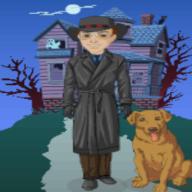為何蘋果會變黃.?!
想要d比較詳細既.
最好就係英文
10分/為何蘋果會變黃.
2007-12-01 10:43 pm
回答 (7)
2007-12-01 10:52 pm
✔ 最佳答案
蘋果變黃是氧化作用。很多人以為蘋果變黃是因為蘋果裡的 "鐵質" 氧化,那是錯誤的(相信大家吃蘋果時沒有吃鐵銹吧?!)
氧化的是 "酚化合物" (Phenol compound)。當這種酵素與空氣中的氧接觸結合,就會產生氧化作用,有色物質出現,令蘋果生銹。
不論用甚麼方法,只要減少蘋果與空氣 (氧氣) 接觸便可以減慢蘋果變黃,而糖水或鹽水一盤合氧量較少,可以大幅減慢氧化。
Apple changes to yellow, this process is known as oxidation.
Many people think that apple changes to yellow is due to the Iron inside it oxidized. In fact, this is wrong. (I suppose everyone didn't eat any rusting iron when eating an apple.)
Actually, the substance causing oxidation is Phenol compound. When Phenol compound combines with the oxygen in the air, oxdation occurs. Therefore, some coloured substances will produce which made the apple turns yellow.
Anyway, you can use any method you like to reduce the apple in contact with the air(Oxygen), so this can slow down the apple turns to yellow.
Normally, sugar solution and salt solution contain fewer oxygen, thus they can reduce the pace of oxidation sharply.
參考: Yahoo! Kwonlegde!
2007-12-01 11:53 pm
因為蘋果有豐富的鐵質,蘋果會變黃係因為蘋果中的鐵質跟空氣發生了氧化作用
Because the apple has abundant iron, it is with the air emergence oxidation because of the iron in the apple that the apple will turn yellow
Because the apple has abundant iron, it is with the air emergence oxidation because of the iron in the apple that the apple will turn yellow
2007-12-01 11:06 pm
你是說皮外或皮內?!
皮內可能是你太耐也未吃
皮內可能是你太耐也未吃
2007-12-01 11:04 pm
蘋果會變黃,因為牠含有多酚氧化酶(polyphenol oxidase,PPO)和過氧化酶(peroxidase,POD),在接觸空氣後,這兩種酶會使蘋果出現氧化,使蘋果內的糖分轉化為有基酸,使蘋果同時變酸。
kiierll,多酚氧化酶(polyphenol oxidase,PPO)和過氧化酶(peroxidase,POD)氧化的不是鐵,而是酚(phenol),這隻酶稱為酚氧化酶,那會氧化鐵,加上蘋果上的鐵,不是金屬鐵,那會被氧化成啡色。那些黃色就是來自被氧化後的酚(phenol)。
點樣可以令蘋果汁吾變:::
+鹽水
+檸檬水
加了檸檬純汁、金桔榨汁、橘子榨汁、市售葡萄柚汁的水的蘋果汁
kiierll,多酚氧化酶(polyphenol oxidase,PPO)和過氧化酶(peroxidase,POD)氧化的不是鐵,而是酚(phenol),這隻酶稱為酚氧化酶,那會氧化鐵,加上蘋果上的鐵,不是金屬鐵,那會被氧化成啡色。那些黃色就是來自被氧化後的酚(phenol)。
點樣可以令蘋果汁吾變:::
+鹽水
+檸檬水
加了檸檬純汁、金桔榨汁、橘子榨汁、市售葡萄柚汁的水的蘋果汁
2007-12-01 10:54 pm
民間流行一種觀念,認為蘋果可以補血,理由是蘋果可以提供鐵質。人們認定蘋果含鐵的原因是,切開的蘋果很容易變成褐色,顏色彷彿鐵器生鏽。這個觀念其實是錯誤的。
蘋果的切口的確會變色,在食品科學上稱為「褐變」。褐變的原因是果實中酵素作用的結果,所以又稱為「酵素性的褐變」,引發褐變的酵素總稱為「多酚氧化酵素」,酵素作用的對象是果實中一些酚類的成分。當果實完整的時候,酵素和酚類成分被細胞的結構分隔,所以不會發生反應;當果實經過切割或加工的時候,細胞結構損壞,酵素和酚類成分有接觸的機會而發生反應。
多酚氧化酵素會將酚類成分氧化,多個小分子的氧化產物經過聚合反應,就生成褐色的色素。許多食物都會發生同樣的褐變,人們接受的態度則因食物而異,蘋果、馬鈴薯或草菇變色令人不悅,可是紅茶、葡萄乾或蘋果汁的顏色則視為自然。
從鐵的觀點來看,根據食品工業研究所編制的「台灣地區食品營養成分資料庫」,五爪蘋果、青玉蘋果、青龍蘋果或是富士蘋果大約是每100公克含有0.1至0.2毫克的鐵。一個蘋果所提供的鐵質只有每日建議量的1﹪,沒有任何補鐵或補血的效應
http://tw.knowledge.yahoo.com/question/?qid=1306031209876
Rust Diseases
There are three rust diseases: cedar-apple rust, hawthorn rust, and quince rust. All three fungi spend part of their life cycle on the eastern red cedar and are problems only when red cedar is found close to the orchard. The most common is cedar-apple rust. These diseases can cause economic losses in several ways. Severe leaf infection and defoliation may make trees susceptible to winter injury. Severe defoliation reduces fruit size and quality, and infected fruit is deformed, sometimes very seriously. Cedar-apple rust occurs on leaves and fruit of apple and crabapple trees. Hawthorn rust occurs on leaves of pear, hawthorn, apple, and crabapple. Quince rust occurs on the leaves and fruit of quince and the fruit of pear, apple, and crabapple.
Symptoms
On leaves, cedar-apple rust, caused by the fungus Gymnosporangium juniperi-virginianae, first appears as small, pale-yellow spots on the upper surfaces. The spots enlarge and eventually, tiny, black, fruiting bodies (pycnia) become visible. Often a number of orange-yellow pustules, called aecia, are produced in each spot on the leaf.
Infected leaves may remain on the tree or may become yellow and drop. Quince rust, caused by the related fungus Gymnosporangium clavipes, does not infect apple leaves but does infect leaves and fruit of quince and hawthorn and can be observed in the spring on cedar branches. Fruit lesions are somewhat like leaf lesions but are much larger and often cause fruit to become disfigured or to develop unevenly.
Light-brown to reddish-brown galls form on the branches of red cedar. When they are dry and hard they may be 1/2 to 2 inches in diameter and are known as "cedar apples." The gall surface is covered with depressions much like those on a golf ball. In the spring, when the "cedar apples" become wet, a yellow-orange, gelatinous horn (telial horn) up to 2 inches long protrudes from each depression. Fruit infected by quince rust are usually puckered and distorted at the calyx end.
Disease Cycle
Spores discharged from these gelatinous telial horns are windborne, infecting apple leaves and fruit. Spore discharge begins about the pink stage of apple bloom and is usually completed in a few weeks. Following a few wet periods, the cedar galls die. Spots on apple leaves can be seen about 10 days after infection. Visible fruit infections require a somewhat longer time.
Aecia (yellow lesions) on the undersides of apple leaves or on fruit lesions themselves produce spores. Borne by winds, the spores may be carried back to the red cedar. After lodging in leaf axils or in crevices on cedar twigs, they germinate, infect the twig, and produce tiny galls the following spring. One year later, these galls produce gelatinous horns bearing spores that can infect apple trees.
Disease Management
Remove red cedar trees from the vicinity of apple trees. Plant scab-resistant apple cultivars, which may also be resistant to rusts. Fungicide applications should be made at the pink bud stage of apple and repeated at 7- to 10-day intervals through petal fall.
http://fpath.cas.psu.edu/Fruit_facts/Apple/rusts.html
蘋果的切口的確會變色,在食品科學上稱為「褐變」。褐變的原因是果實中酵素作用的結果,所以又稱為「酵素性的褐變」,引發褐變的酵素總稱為「多酚氧化酵素」,酵素作用的對象是果實中一些酚類的成分。當果實完整的時候,酵素和酚類成分被細胞的結構分隔,所以不會發生反應;當果實經過切割或加工的時候,細胞結構損壞,酵素和酚類成分有接觸的機會而發生反應。
多酚氧化酵素會將酚類成分氧化,多個小分子的氧化產物經過聚合反應,就生成褐色的色素。許多食物都會發生同樣的褐變,人們接受的態度則因食物而異,蘋果、馬鈴薯或草菇變色令人不悅,可是紅茶、葡萄乾或蘋果汁的顏色則視為自然。
從鐵的觀點來看,根據食品工業研究所編制的「台灣地區食品營養成分資料庫」,五爪蘋果、青玉蘋果、青龍蘋果或是富士蘋果大約是每100公克含有0.1至0.2毫克的鐵。一個蘋果所提供的鐵質只有每日建議量的1﹪,沒有任何補鐵或補血的效應
http://tw.knowledge.yahoo.com/question/?qid=1306031209876
Rust Diseases
There are three rust diseases: cedar-apple rust, hawthorn rust, and quince rust. All three fungi spend part of their life cycle on the eastern red cedar and are problems only when red cedar is found close to the orchard. The most common is cedar-apple rust. These diseases can cause economic losses in several ways. Severe leaf infection and defoliation may make trees susceptible to winter injury. Severe defoliation reduces fruit size and quality, and infected fruit is deformed, sometimes very seriously. Cedar-apple rust occurs on leaves and fruit of apple and crabapple trees. Hawthorn rust occurs on leaves of pear, hawthorn, apple, and crabapple. Quince rust occurs on the leaves and fruit of quince and the fruit of pear, apple, and crabapple.
Symptoms
On leaves, cedar-apple rust, caused by the fungus Gymnosporangium juniperi-virginianae, first appears as small, pale-yellow spots on the upper surfaces. The spots enlarge and eventually, tiny, black, fruiting bodies (pycnia) become visible. Often a number of orange-yellow pustules, called aecia, are produced in each spot on the leaf.
Infected leaves may remain on the tree or may become yellow and drop. Quince rust, caused by the related fungus Gymnosporangium clavipes, does not infect apple leaves but does infect leaves and fruit of quince and hawthorn and can be observed in the spring on cedar branches. Fruit lesions are somewhat like leaf lesions but are much larger and often cause fruit to become disfigured or to develop unevenly.
Light-brown to reddish-brown galls form on the branches of red cedar. When they are dry and hard they may be 1/2 to 2 inches in diameter and are known as "cedar apples." The gall surface is covered with depressions much like those on a golf ball. In the spring, when the "cedar apples" become wet, a yellow-orange, gelatinous horn (telial horn) up to 2 inches long protrudes from each depression. Fruit infected by quince rust are usually puckered and distorted at the calyx end.
Disease Cycle
Spores discharged from these gelatinous telial horns are windborne, infecting apple leaves and fruit. Spore discharge begins about the pink stage of apple bloom and is usually completed in a few weeks. Following a few wet periods, the cedar galls die. Spots on apple leaves can be seen about 10 days after infection. Visible fruit infections require a somewhat longer time.
Aecia (yellow lesions) on the undersides of apple leaves or on fruit lesions themselves produce spores. Borne by winds, the spores may be carried back to the red cedar. After lodging in leaf axils or in crevices on cedar twigs, they germinate, infect the twig, and produce tiny galls the following spring. One year later, these galls produce gelatinous horns bearing spores that can infect apple trees.
Disease Management
Remove red cedar trees from the vicinity of apple trees. Plant scab-resistant apple cultivars, which may also be resistant to rusts. Fungicide applications should be made at the pink bud stage of apple and repeated at 7- to 10-day intervals through petal fall.
http://fpath.cas.psu.edu/Fruit_facts/Apple/rusts.html
參考: fm above 2 websites
2007-12-01 10:51 pm
When an apple is cut (or bruised), oxygen is introduced into the injured plant tissue. When oxygen is present in cells, polyphenol oxidase (PPO) enzymes in the chloroplasts rapidly oxidize phenolic compounds naturally present in the apple tissues to o-quinones, colorless precursors to brown-colored secondary products. O-quinones then produce the well documented brown color by reacting to form compounds with amino acids or proteins, or they self-assemble to make polymers.
In short, apple has a huge amount of iron in it. When exposed to air, iron gets oxidies and turin into brown color!!
In short, apple has a huge amount of iron in it. When exposed to air, iron gets oxidies and turin into brown color!!
2007-12-01 10:49 pm
因為在空氣中,擺得久.
收錄日期: 2021-04-14 00:59:04
原文連結 [永久失效]:
https://hk.answers.yahoo.com/question/index?qid=20071201000051KK01949



